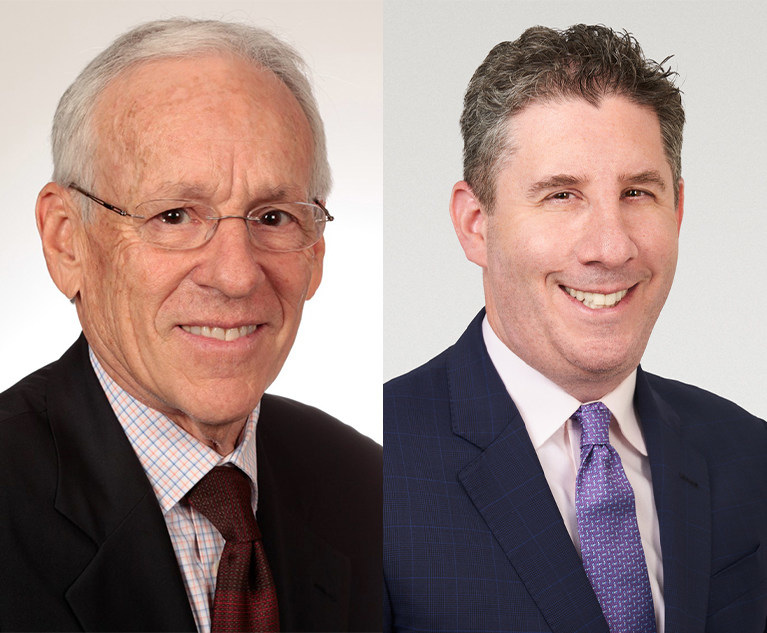 Kenneth M. Block, left, and Stuart B. Rosen. Partners at Tannenbaum Helpern Syracuse & Hirschtritt. Courtesy Photos.
Kenneth M. Block, left, and Stuart B. Rosen. Partners at Tannenbaum Helpern Syracuse & Hirschtritt. Courtesy Photos.Sustainable Construction: Navigating NYSERDA Grants
In their Construction Law column, Kenneth Block and Stuart Rosen provide a guide for working through the applicable terms and conditions of New York State Energy Research and Development Authority (NYSERDA), while maintaining the balance between the autonomy of the stakeholder versus compliance and administration of NYSERDA’s project requirements.
November 12, 2024 at 12:46 PM
6 minute read
As part of the ambitious goals of New York State's Climate Leadership and Community Protection Act (CLCPA), including 100% zero-emission electricity by 2040 and a complete emissions reduction (no fossil fuels) in New York by 2050, real estate owners and developers (“stakeholders”) are faced with the daunting and costly task of bringing their existing buildings and new projects within compliance.
To alleviate this burden, the New York State Energy Research and Development Authority (NYSERDA), through the establishment of The Clean Energy Fund, has committed to funding a significant number of incentive programs and grants directed at stakeholders seeking to increase energy efficiency, develop renewable energy, and achieve emissions reduction.
However, like the stringent requirements of a typical construction lender or public grant, the NYSERDA terms and conditions include certain obligations that stakeholders must negotiate and navigate while administering their construction projects.
This article provides a guide for working through the applicable terms and conditions, while maintaining the balance between the autonomy of the stakeholder versus compliance and administration of NYSERDA’s project requirements.
NYSERDA’S Terms and Conditions
NYSERDA grants provide important financial incentives and funding for energy efficient projects, though retrofitting, retro-commissioning, de-carbonization and electrification of new and existing buildings.
As part of the grant process, stakeholders should thoroughly understand the grant requirements with which they and their contractors (of every tier) must comply throughout the project. The terms and conditions often include a strict project schedule with firm expiration dates tied to the availability of the funding, which do not readily carve out unforeseen circumstances, such as force majeure or contractor delays, or failure on the part of NYSERDA to timely provide its required signoffs.
From a cost standpoint, NYSERDA often attempts to lock-in a fixed budget and stipulated billing rates in the grant agreement; however, it is important to ensure that such billing rates, including potential annual increases, of contractors, design professionals and consultants are properly incorporated into the grant.
Additionally, NYSERDA’s audit, invoicing and payment terms often require a level of detail that is greater than the level of detail provided by stakeholders’ vendors.
The subcontracting procedures set forth in NYSERDA grants are also more stringent than the typical lender requirements imposed on prime contractors, including NYSERDA’s right to approve all subcontractors.
Owners and their prime contractors also cannot terminate a subcontract without NYSERDA’s permission, unless a substitute subcontractor is accepted by NYSERDA, in its sole discretion. The stakeholder should also reserve the right to fund the remainder of the project and retain the subcontractors should NYSERDA elect to terminate the grant.
From an insurance standpoint, stakeholders must ensure that the strict insurance requirements in the grant can be satisfied by all third parties retained directly or indirectly by the stakeholders, including any subcontractors.NYSERDA does not typically cover the cost of a builder’s risk or all-risk policy for the stakeholder. Nonetheless, stakeholders are strongly encouraged to consult their risk managers and brokers regarding the procurement of such coverage.
Lastly, NYSERDA ultimately reserves the right in the grant to issue stop work orders on ten days’ notice, for convenience, which could significantly impact projects, especially when there are various third parties engaged for the project.
Each subcontract agreement must properly flow-down the suspension and termination provisions of the grant, including the allotted cost and schedule impacts. Otherwise, stakeholders could be on the hook for any other termination or demobilization costs.
NOT FOR REPRINT
© 2025 ALM Global, LLC, All Rights Reserved. Request academic re-use from www.copyright.com. All other uses, submit a request to [email protected]. For more information visit Asset & Logo Licensing.
You Might Like
View All



Trending Stories
- 1Consumer Protection Suit Cleared to Go Forward Against Irritating Eye Serum
- 2COVID-19 Was Still Relevant in Securities Class Actions During 2024, Report Says
- 3After Botched Landing of United Airlines Boeing 767, Unlikely Plaintiff Sues Carrier
- 4DOT Moves to Roll Back Emissions Rules, Eliminate DEI Programs
- 5No Injury: Despite Proven Claims, Antitrust Suit Fails
Who Got The Work
J. Brugh Lower of Gibbons has entered an appearance for industrial equipment supplier Devco Corporation in a pending trademark infringement lawsuit. The suit, accusing the defendant of selling knock-off Graco products, was filed Dec. 18 in New Jersey District Court by Rivkin Radler on behalf of Graco Inc. and Graco Minnesota. The case, assigned to U.S. District Judge Zahid N. Quraishi, is 3:24-cv-11294, Graco Inc. et al v. Devco Corporation.
Who Got The Work
Rebecca Maller-Stein and Kent A. Yalowitz of Arnold & Porter Kaye Scholer have entered their appearances for Hanaco Venture Capital and its executives, Lior Prosor and David Frankel, in a pending securities lawsuit. The action, filed on Dec. 24 in New York Southern District Court by Zell, Aron & Co. on behalf of Goldeneye Advisors, accuses the defendants of negligently and fraudulently managing the plaintiff's $1 million investment. The case, assigned to U.S. District Judge Vernon S. Broderick, is 1:24-cv-09918, Goldeneye Advisors, LLC v. Hanaco Venture Capital, Ltd. et al.
Who Got The Work
Attorneys from A&O Shearman has stepped in as defense counsel for Toronto-Dominion Bank and other defendants in a pending securities class action. The suit, filed Dec. 11 in New York Southern District Court by Bleichmar Fonti & Auld, accuses the defendants of concealing the bank's 'pervasive' deficiencies in regards to its compliance with the Bank Secrecy Act and the quality of its anti-money laundering controls. The case, assigned to U.S. District Judge Arun Subramanian, is 1:24-cv-09445, Gonzalez v. The Toronto-Dominion Bank et al.
Who Got The Work
Crown Castle International, a Pennsylvania company providing shared communications infrastructure, has turned to Luke D. Wolf of Gordon Rees Scully Mansukhani to fend off a pending breach-of-contract lawsuit. The court action, filed Nov. 25 in Michigan Eastern District Court by Hooper Hathaway PC on behalf of The Town Residences LLC, accuses Crown Castle of failing to transfer approximately $30,000 in utility payments from T-Mobile in breach of a roof-top lease and assignment agreement. The case, assigned to U.S. District Judge Susan K. Declercq, is 2:24-cv-13131, The Town Residences LLC v. T-Mobile US, Inc. et al.
Who Got The Work
Wilfred P. Coronato and Daniel M. Schwartz of McCarter & English have stepped in as defense counsel to Electrolux Home Products Inc. in a pending product liability lawsuit. The court action, filed Nov. 26 in New York Eastern District Court by Poulos Lopiccolo PC and Nagel Rice LLP on behalf of David Stern, alleges that the defendant's refrigerators’ drawers and shelving repeatedly break and fall apart within months after purchase. The case, assigned to U.S. District Judge Joan M. Azrack, is 2:24-cv-08204, Stern v. Electrolux Home Products, Inc.
Featured Firms
Law Offices of Gary Martin Hays & Associates, P.C.
(470) 294-1674
Law Offices of Mark E. Salomone
(857) 444-6468
Smith & Hassler
(713) 739-1250






